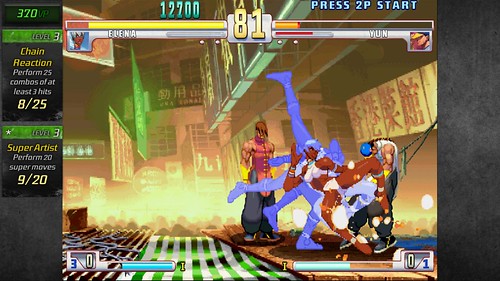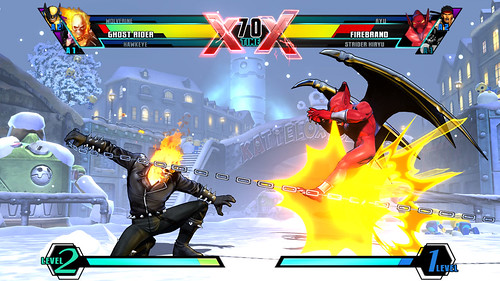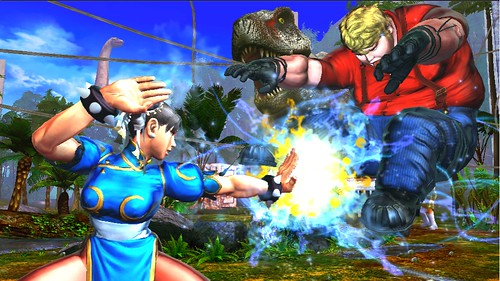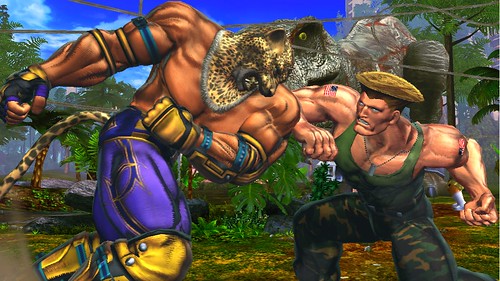
Capcom’s fighting-game renaissance surges forward like an EX Hadoken. This August sees the long-awaited PSN release of Street Fighter III: 3rd Strike Online Edition, followed by Ultimate Marvel vs Capcom 3 in November and Street Fighter X Tekken in 2012. I caught up with Capcom’s Strategic Director of Online & Community Seth Killian at EVO, the world’s biggest fighting game tournament, to get the latest updates on all three games.
Killian did me one better, discussing Capcom’s evolving view of community engagement and sharing his analysis of Noah “The Prodigy,” the eight-year old Marvel vs Capcom 3 competitor who captured the imagination of EVO attendees when he outmatched much older players to place among the competition’s top 64 finalists.
PlayStation.Blog: Street Fighter III was famously a huge departure from Street Fighter II, earning it a fair bit of controversy. How does it hold up today?
Seth Killian, Strategic Director of Online & Community: For me, the essence of any great fighting game is learning how to read the mind of your opponent. If you can do that, Street Fighter III gives you the ultimate way to show that off — you can deflect any move that your opponent can do using the Parry mechanic, where you tap forward or down to deflect attacks. The Parry is at the center of SFIII; if you use it correctly, you can get out of any situation. That’s why it has this enduring legacy.
As for its reputation, there’s no question that SFIII is an incredible game. It has a huge tournament legacy, particularly in Japan. It’s one of those games where the execution bar is a little bit higher: it took everything that had come before and built and built upon it. Particularly with the Parry, which is a bit harder to learn — you need to be familiar with the kind of attack that is coming, knowing how it hits and how many times it hits. With Street Fighter III: 3rd Strike Online Edition, we’ve added a new mode to specifically help people understand that Parry, practice it, and get comfortable with it.
PSB: Aside from the training mode, what else is Capcom bringing to SFIII: 3rd Strike Online Edition?
SK: We wanted to preserve the integrity of the game, so we used the arcade code and removed a few minor crash bugs. Otherwise, the core gameplay is untouched. We did add a few extras to the online and single-player modes, including the ability to unlock items though in-game challenges. It brings a little bit of that Call of Duty, carrot-on-a-stick incentive but it’s purely optional.
Online is a key focus. We’ve added new netcode developed by the EVO organizer, who happens to be a programming genius who created a piece of middleware called GGPO. It’s extremely popular with fighting fans because it’s a great online experience; it was designed by hand for 2D fighters. It has some very crafty ways of getting around input lag. It doesn’t defeat the speed of light or anything, but it uses a fixed frame setup. It will skip frames of animation to hide latency, which makes an attack finish at the same time as it would if we were playing offline. I’ve never heard a piece of middleware get an eruption of cheers at a panel, so that’s how seriously this is taken among fighting-game fans.
We also have online tournament and spectator modes, plus YouTube uploads that enable you to share your favorite matches with your friends whether you’re on your PS3 or off it.
PSB: Ultimate Marvel vs Capcom 3 comes this fall. Other than the new characters, what new features will be included?
SK: They’re going back to the drawing board with some of the netcode, and adding a spectator mode — a major request from the North American and Japanese fans. It’s particularly challenging for a hyper-busy game like Marvel vs Capcom 3, but the team did manage to figure it out.
There will also be some additional single-player surprises, some new graphical elements, and of course re-tuning for the existing characters. There are little changes to certain moves, and sometimes all-new moves, animation tweaks…it’s a complete package and coming in at a lower price point. If you missed out on Marvel vs Capcom 3, this is the perfect time to dive in.
PSB: Tell me about this eight-year old kid, Noah “The Prodigy,” who fought his way into the top 64 players in the Marvel vs. Capcom 3 EVO world finals. Is he as good as they say?
SK: He was finally eliminated, but he took down some of the best players in the world. His brother is in the competitive fighting scene, so this kid has grown up with this stuff. The thing that distinguishes Noah is, here’s got skills, but he’s very composed. He’s got this weird calm for an eight year-old kid playing on stage in front of hundreds of thousands of people. We’ve had 12- or 13-year old competitors who have done some damage, but Noah is unprecedented. He took out real players. I think he’s got an amazing competitive career ahead of him.
Once he develops more agility and insight he’s got a lot of room to grow, even using his existing gameplan. He also played some slightly unusual characters, and his opponents may not have been ready for that.
PSB: Let’s shift to Street Fighter X Tekken, one of the more unusual fighters to come out of Capcom in recent memory. How much of Tekken’s gameplay made the cut?
SK: It’s set in a Street Fighter world on a 2D fighting plane but, at the same time, we’ve tried to preserve some of the Tekken elements. For me, the essence of Tekken is getting in your opponent’s face and forcing him to guess between your high, low, and mid mix-up attacks. Not only are the Tekken characters performing some of their signature moves, they’re able to do it in the same sort of style. They have a more fluid ability to execute those kinds of mix-up attacks. The Street Fighter characters are a little stronger at a range with their projectiles. The other nod to Tekken is that many of the traditional Tekken combo strings will still work.
PSB: How can the Tekken characters get past those projectiles? It seems like a major disadvantage.
SK: I feel like, in many ways, there’s less difference between Tekken and Street Fighter than people often think. In Tekken, you have sidestepping — moving into the third dimension to dodge attacks. In Street Fighter, you have a similar concept: Cammy, for example, can use her Spinning Backfist move to flip around an incoming projectile if you time it correctly. From a game design perspective, it’s quite similar — she’s briefly moving into the third dimension to dodge that fireball. The Tekken characters have moves that work much like that, where they spin, dash, or slide around projectiles. So the Tekken characters are very adept at passing through projectiles if you read your opponent correctly.
PSB: Explain this new “Tag Assault” move, where you call out both of your characters to pummel your opponent.
SK: Street Fighter X Tekken is a tag-centric game, an homage to Tekken Tag Tournament, so you can tag normally or cancel a special move into a tag. With the Tag Assault technique, you can bring in both of your teammates at the same time — you control them both simultaneously. Then you can do all sorts of dirty tricks like creating a sandwich so you can ping-pong your opponent between both of your fighters from both sides. It’s actually really strong right now — we’ll probably tone it down a bit as we move forward.
PSB: We’re surrounded by some of the best fighters in the world here at EVO. What are they saying about Street Fighter X Tekken? What’s the feedback been so far?
SK: I get worried, because this is the toughest audience in the world. If these guys are good at anything besides fighting, they’re good at complaining. [laughs] They will let you know exactly what’s wrong with your game. The worst complaints we’ve had to date has revolved around certain UI elements and the lifebar being hard to read. Ono-san has already gone back to the drawing board to re-tool them.
In terms of gameplay, people seem to be walking away with a smile on their face. Which actually just makes me nervous! I want to say, “Guys, this is the time! Let us know what you love and what you hate.” So far, it’s sort of a half-step between Street Fighter and Marvel vs. Capcom 3.
So right now, the EVO crowd is digging in and finding the worst possible things they can do to each other.
PSB: Fighting game creators haven’t always been hugely receptive to their fans. But Capcom has clearly led the way in terms of enabling community feedback. What’s the philosophy there?
SK: It’s been a learning process. Capcom is a traditional Japanese company, and Japanese companies tend to engage in one-way communication. You know: “Here is what we are doing. Please enjoy. We’ll see you again in a year.” [laughs] There wasn’t a lot of back-and-forth there.
But today’s social media tools have changed the game. Capcom, I think, has led the pack among the Japanese game publishers in adapting to that — though obviously, PlayStation is no slouch either! Capcom has been aggressive with community interaction and they’ve seen the power of it. I’m proud to be a part of it because I came from this very community, the EVO community. It’s how I got my start at Capcom.
It’s not a matter of being bound by the demands of fans. You know, “well, fans voted to put a clown wig on Ryu, so that’s what we have to do.” It’s about good ideas, and fans have some of the best ideas in the world. Being able to bring those ideas forward and presenting them to the right people who can evaluate them is what it’s all about.
The games are all here at EVO for a reason: the designers want to hear feedback from the fans. As a business, you need to be responsive to the concerns of your fans, or you’re doing it wrong. It’s smart business to have a real dialogue with your fans.


















Comments are closed.
37 Comments
Loading More Comments